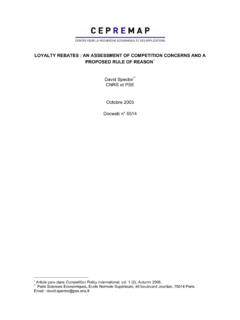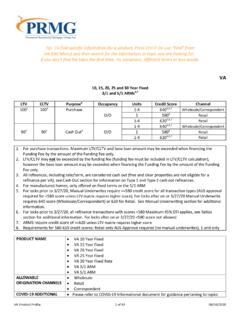Transcription of PREDATORY PRICING - OECD
1 PREDATORYPRICINGORGANISATION FOR ECONOMIC CO-OPERATION AND DEVELOPMENT2 This report covers PREDATORY PRICING , PRICING so low that competitors quit rather than compete,permitting the predator to raise prices in the long run. PREDATORY PRICING is subject to the competition lawsand policies of most OECD countries, but there has been a lively controversy over what standards shouldbe applied. Some officials go so far as to urge that any rule against predation will do more harm thangood by depriving consumers of the benefits of vigorous price report examines the conflicting proposals for a standard to control PREDATORY PRICING andrecommends a method of analysis which competition officials should follow. Major emphasis is given toidentifying when low PRICING should not be of concern to competition authorities. OECD 19893 TABLE OF ECONOMICS OF 7A.
2 PREDATORY 7B. Non-Price Predation .. 11C. Discussion .. 12 III. THE FREQUENCY OF PREDATORY FOR CONTROLLING PREDATORY 19A. No Rule .. 19B. Short-Run Cost-Based Rules .. 20C. Long-Term Cost-Based Rules .. 21D. Output Expansion Rules .. 22E. Rules Governing Price Rises .. 23F. Industry-Specific 24G. Rule-of-Reason 24H. Two-Tier 26I. Discussion .. MECHANISMS TO CONTROL PREDATION .. 29 Australia .. 29 Austria .. 31 Belgium .. 31 Canada .. 33 Finland .. 34 Ireland .. 36 New Zealand .. 37 Portugal .. 38 Sweden .. 38 United 38 United States .. 39 European Community .. 434 Discussion .. 45 Australia .. 45 Belgium .. 46 Canada .. 51 Germany .. 58 Sweden .. 58 United 59 United States .. 62 European Community .. 70 Discussion .. 72 VII. 75 NOTES AND 78 Chapter II .. 78 Chapter III .. 80 Chapter 81 Chapter V .. 85 Chapter 895I. INTRODUCTIONThe subject of PREDATORY conduct, PREDATORY PRICING in particular, is topical again.
3 Several trendshave converged which make an examination of predation timely. The first is the sweeping movementthroughout the OECD to increase competition and efficiency through the deregulation of numeroussectors and the privatisation of state-owned enterprises. This movement raises concerns that the newlyfreed firms, often dominant in their markets, will seek unfairly to protect their positions against newentrants. Second, there is the increasingly difficult area of international trade, where economicdislocations in connection with rising imports have caused many domestic industries to charge theirforeign competitors with dumping. This increasing concern over international trading practices couldbenefit from clear thinking about what PRICING should be considered economic literature on PREDATORY PRICING has likewise been in a state of flux.
4 Although earlytheorists made intuitive arguments on the dangers of predation, this view has been largely displaced bytheories that price predation is irrational and should therefore be rare. While this latter view has becomethe conventional wisdom affecting the formation of PRICING rules and decisions by courts and competitionpolicy officials, still more recent theories have cropped up arguing that PREDATORY PRICING can indeed berational in certain circumstances. To the extent that these newer views are correct, heightened concernover predation is recent phenomenon is the emergence of concern over non-price predation. Non-pricepredation, sometimes called raising rivals costs, includes the abuse of judicial and administrativeprocedures to impede domestic and foreign competitors. Because the rules against PREDATORY PRICING anddumping are natural weapons for the non-price predator, it is important that these rules be no broader thannecessary; rules which are overbroad or imprecise invite their abuse for anticompetitive predation is not the only reason why PREDATORY PRICING rules must be carefully drawn;an imprecise rule carries real risks of costly errors.
5 Mistaking competitive PRICING as PREDATORY will tendto inhibit price competition in the economy. On the other hand, mistaking predation for competition mayfoster higher prices from increased concentration in the long run. In light of these considerations,competition authorities should not take action unless the existence of PREDATORY PRICING can be establishedwith a reasonable degree of accuracy and should recognize that it may be better to have no explicit ruleprohibiting PREDATORY PRICING than to mechanically enforce such a of one type or another concerning PREDATORY conduct are found in the competition lawsand policies of most Member countries. These rules typically prohibit abuse of dominant position, effortsto monopolize a market or price discrimination to injure competition in a market. In addition, a fewMember countries have particular legislation prohibiting sales below some cost floor, generally withoutreference to the market power of the firm or the effect of the practice on competition.
6 These sale-at-a-lossprohibitions are described even though they might not normally be considered to be predation rules. Theycould, nonetheless, operate in the same fashion as a cost-based anti-predation rule. Thus, any lessonsdrawn from examining the latter type rules could illuminate the former. In addition, provisions relating to loss-leader and advertised but unavailable items exist in some Member countries but are not examinedin this report. Provisions of this type are as often found under consumer protection regimes as they are6under competition policy, and thus go beyond the scope of the present study. This report describes brieflythe legal framework in each Member country as well as significant cases arising under those laws. Itshould be kept in mind, however, that a number of Member countries report that no such cases have yetarisen under their laws.
7 In addition, a number of necessary elements in the treatment of a predatorypricing case are beyond the scope of this report. For example, questions concerning market definition andwhat constitutes a dominant position or market power are not report defines predation as short-run conduct which seeks to exclude rivals on a basis otherthan efficiency in order to protect or acquire market power. Such exclusion can be attempted throughshort-run PRICING so low as to induce exit or deter entry, or through non-price conduct which can, inaddition, put rivals at a disadvantage by raising their costs. Longer run entry-deterring conduct such aslimit PRICING is not within the scope of this report. This report discusses the theories of both price andnon-price predation, but its primary emphasis will be on the former as the evolution of legal rulesgoverning PREDATORY PRICING has been the subject of considerable controversy in recent academic debate over the appropriate PREDATORY PRICING rule is reflected in several ways inthis report.
8 First, a chapter is given over to a presentation of the major proposals. Second, an effort ismade in the discussion of the case law to uncover to what extent the various proposals have been acceptedor rejected by courts and competition policy officials. This case law discussion shows, moreover, howantitrust concepts circulate internationally. In particular, proposals generated in the American academicdebate over PREDATORY PRICING rules have begun to find their way into competition law decisions of otherMember countries. For example, in a recent decision in the European Community, the defendant, a Dutchfirm, argued that its PRICING should not be seen as an abuse of dominant position given the reasoning ofAreeda and Turner, authors of an influential article which appeared in the Harvard Law Review. Thus, theacademic debate should be of interest to competition policy officials and practitioners in each organisation of the report is as follows: Chapter 2 presents the theories of price and non-price predation.
9 Chapter 3 discusses the available information on the prevalence of PREDATORY 4 presents the major proposals to govern PREDATORY PRICING which have emerged in the pastdecade. Chapter 5 identifies the legal basis to control PREDATORY PRICING in Member countries whileChapter 6 examines the application of those laws and competition policies in concrete situations. Finally,Chapter 7 presents conclusions and suggestions for the analysis of claims of PREDATORY THE ECONOMICS OF PREDATIONA. PREDATORY pricingThe traditional theory of PREDATORY PRICING is straightforward. The predator, already a dominantfirm, sets its prices so low for a sufficient period of time that its competitors leave the market and othersare deterred from entering. Assuming that the predator and its victims are equally efficient firms, thisimplies that the predator as well as its victims has incurred losses and that these losses are significant.
10 Forthe predation to be rational, there must be some expectation that these present losses (or foregone profits),like any investment, will be made up by future gains. This in turn implies that the firm has somereasonable expectation of gaining exploitable market power following the PREDATORY episode, and thatprofits of this later period will be sufficiently great to warrant incurring present losses or foregoing presentprofits. The theory also implies that some method exists for the predator to outlast its victim(s), whetherthrough greater cash reserves, better financing or cross-subsidisation from other markets or other traditional view was later supplemented by an argument that the potential benefits to thepredator were not limited to future gains in the market where it predated. The PREDATORY campaign couldbe, seen as an investment in reputation which could pay dividends in other geographic or product marketsby deterring entry or disciplining rivals1.

















